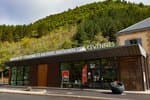
2. From Sainte-Enimie to Ispagnac via the Causse de Sauveterre - Day 2
7 points of interest
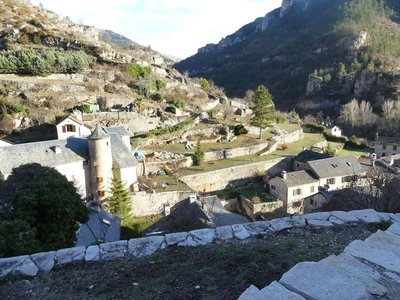
Les terrasses - nathalie.thomas AgricultureThe terraces
Locals have transformed the rocky slopes into hanging gardens by making use of the smallest of flat spaces. They carried the soil up in baskets or sacks on their backs. This is where they would have planted their vegetables and fruit trees (peach, walnut, almond). Until the early 20th century, almond trees were the “great resource” that made good use of soils too poor for other crops.
Until 1851, there were 54 hectares of grapevines for 850 inhabitants. The vineyards clung to 45-degree slopes, which made work difficult. The low yield, disease and mechanisation were all factors in the abandonment of this crop. The municipality of Ispagnac reintroduced vines in 2003 when a winemaker settled there; a second settled in Blajoux in 2006.
Domaine de Boisset - nathalie.thomas  History
HistoryDomaine des Boissets
The stone framework of several windows suggests that the first buildings were built as early as the 15th. The farm was operational until 1960.The hamlet consists of six buildings, houses, outbuildings and sheepfolds, in the typical Caussenard style. The internal courtyard was closed off by walls that were much higher than they are today. A bread oven, cisterns and threshing floor complete the complex, showing that the inhabitants lived in autarky.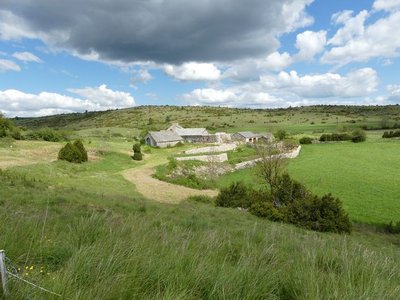
Jouanas - nathalie.thomas  Architecture
ArchitectureTonnas and Nissoulogres
These buildings have been turned into homes or holiday homes. They were once baraques or jasses, built by the inhabitants of the valleys to house people and livestock for a few weeks in the summer: the former harvested the grain they grew in the dolines, the latter grazed the summer pastures.
Voûte du Mas André - Nathalie Thomas AgricultureMas André
Mas are estates or small hamlets. Currently, two families of livestock farmers live in Mas André where they raise sheep for meat (500 to 600 animals). As you leave the hamlet, do stop in front of a complex of ruins with superb stone vaults. Vaulting was often used on both the lower and upper floor, and for both attics and to. The absence of water and of timber for roof structures, the fear of house fires and the abundance of stone explain this type of construction. In fact, a wooden roof could not carry a covering made of limestone tiles – it is too heavy (400 to 500 kg/m²).
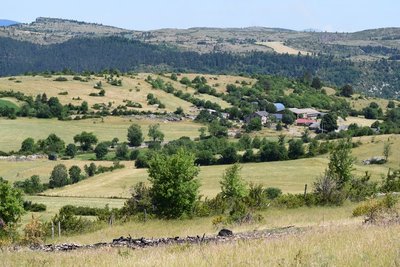
Haie autour du Mas André - C-C Florac - Sud Lozère  Flora
FloraHedges
Hedges (boxwood or thorn bushes) were much used by farmers until the early 20th century to protect crops, flora and fauna, and delimit plots of land. They are the preferred nesting sites of many breeding or migrating birds. They also serve as a hide, not only for birds of prey such as buzzards, sparrowhawks or harriers, but also for insect-eating bids like the Hodgson's redstart and shrike. The berries of certain shrubs (sloe, juniper and dog rose) turn these hedges into larders for seed-eating birds: thrushes, northern grosbeak-canary, ortolan buntings, etc.
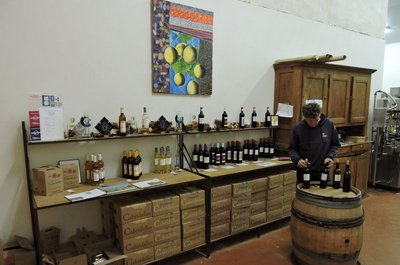
La cave viticole d'Ispagnac - cevennes-gorges-du-tarn AgricultureThe vintners of Ispagnac
In 2003, Sylvain Gachet, from Savoy, reintroduced grapevines to Ispagnac and Florac, planting six hectares of terraced land. On soils of clay/limestone and schist, he attempted to breathe new life into the Domaine de Gabalie. In 2006, Elisabeth Boyé and Bertrand Servières set up as vintners in the Tarn gorge, also under the stimulus package bringing vineyards back to the valley. They cleared the land of the bartas (brambles) which had invaded almost all the parcels, and rebuilt the dry-stone walls before planting almond trees, vine peaches and five hectares of grapevines: the Domaine des Cabridelles was born. The winemakers share a cooperative cellar in Ispagnac, which is also a sales outlet. Why not make a short stop to try the wines (the cellar is next to the car park by the state school (école publique).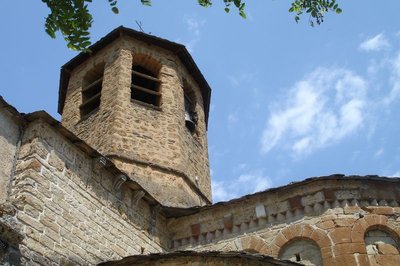
Chevet de l'église d'Ispagnac - cevennes-gorges-du-tarn  Architecture
ArchitectureIspagnac church
St-Peter’s Church in Ispagnac is one of the finest examples of Romanesque architecture in Gévaudan. Built in the 12th century, it is dedicated to Saint Peter and Saint Paul. The understated facade of this bulky-looking building has a simple gate with three semi-circular arches topped by a rose window that lets light into the nave. Once inside, you discover a simple and airy architecture. A sound-and-light show helps you to explore. To get the fullest impression of the architecture, you need to leave the building and walk around it to see the apse and its décor.
Description
1- By the Hotel Burlatis, take Rue de la Combe, which climbs to the upper village for 200 m. Take the road on your right, which is tarred at first, and continue on the path that climbs to the Domaine des Boissets, waymarked yellow (steep climb). Pass to the left of the Domaine.
2 – At the road, turn right and continue for 500 m, then turn right again. Follow the waymarks for GRP Tour du Causse de Sauveterre (yellow and red). Pass the hamlet of Jouanas.
3 – By the hamlet of Nissoulogres, take on your right the path towards the edge of the plateau.
4 – Leave the path, which descends into the gorge, and instead follow on your left the path along the edge of the Causse.
5 – At the crossroads with the path on the right that goes down to Le Villaret in the gorge, turn left towards the hamlet of Tonnas and continue on the track towards the hamlet of Le Mas André.
6 – Ignore the road on the left and instead take the old path on the left, which joins up with the road after 300 m.
7 – Continue on the lane for 300 m and take on your right the path that goes down towards the vale of Ispagnac.
8 – At the road, turn right then left towards Ispagnac. After the bridge, immediately turn right in the hamlet of Molines and go down to the river. Take on your left the path along the Tarn.
9 – At Quézac bridge, continue straight ahead along the Tarn and return, past the campsite and then on Rue des Barrys, to the centre of Ispagnac.
- Departure : Sainte-Enimie
- Arrival : Ispagnac
- Towns crossed : Gorges du Tarn Causses and Ispagnac
Forecast
Altimetric profile
Recommandations
Make sure your equipment is appropriate for the day’s weather conditions. Remember that the weather changes quickly in the mountains. Take enough water, wear sturdy shoes and put on a hat. Please close all gates and barriers behind you.
Information desks
Tourism office Cévennes Gorges du Tarn, Ispagnac
Place de l'Église, 48320 Ispagnac
This office is part of the National Park's associated tourist-information network, whose mission is to provide information on, and raise awareness of, the sites and events as well as the rules that must be observed in the National Park's central zone.
Open year-round
Tourism office Cévennes Gorges du Tarn, Sainte-Enimie
village, 48210 Sainte-Enimie
This office is part of the National Park's associated tourist-information network, whose mission is to provide information on, and raise awareness of, the sites and events as well as the rules that must be observed in the National Park's central zone.
Tourism'house and national Parc at Florac
Place de l'ancienne gare, N106, 48400 Florac-trois-rivières
This office is part of the National Park's associated tourist-information network, whose mission is to provide information on, and raise awareness of, the sites and events as well as the rules that must be observed in the National Park's central zone.
On site: exhibitions, video projections, events and shop Open year-round
Transport
Bus line “Florac – Sainte Enimie – Le Rozier”, every day in July and August
https://lio.laregion.fr/
Access and parking
Parking :
Calculateur d'itinéraire Lio
Utilisez le calculateur liO pour organiser votre trajet en région Occitanie.
Autres régions
Calculez votre itinéraire en Auvergne Rhône Alpes sur Oùra
Biodiversité autour de l'itinéraire
Report a problem or an error
If you have found an error on this page or if you have noticed any problems during your hike, please report them to us here:



